Key takeaways:
- Dialogic transformation enhances learning through authentic dialogue, fostering community and deeper understanding.
- Creating a safe environment, practicing active listening, and being adaptable are crucial for effective facilitation.
- Incorporating reflective moments and open-ended questions can significantly improve participant engagement and dialogue richness.
- Vulnerability among participants and acknowledgment of non-verbal cues can lead to transformative discussions and richer insights.
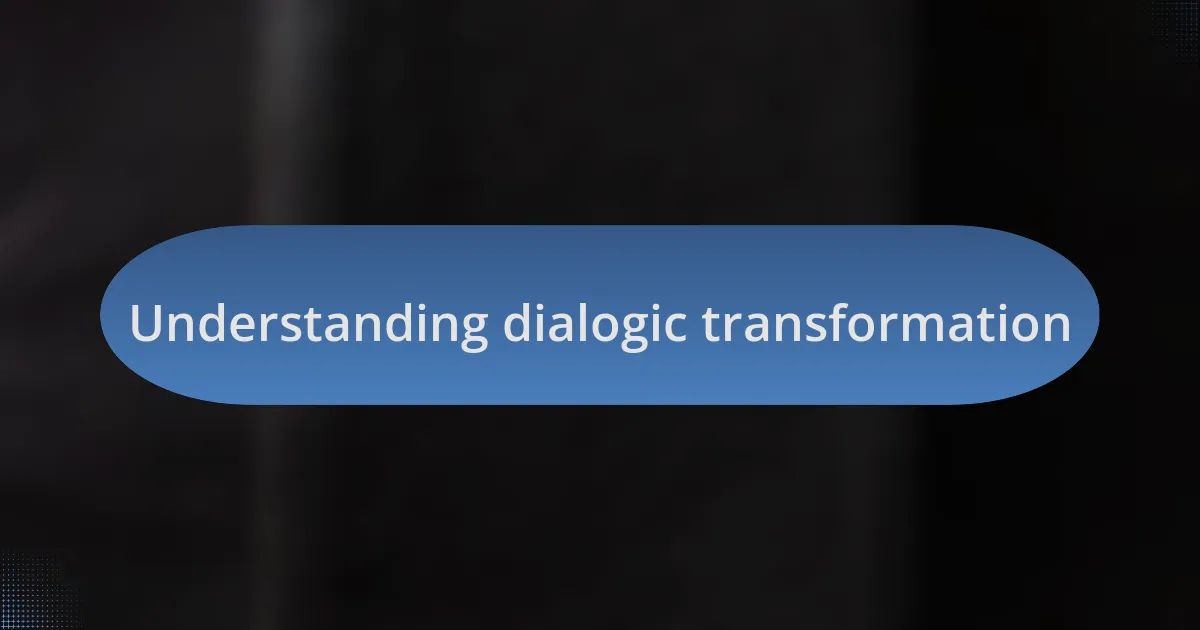
Understanding dialogic transformation
Dialogic transformation refers to the profound changes that occur when genuine dialogue takes place within educational settings. From my experience, when participants engage in open conversations, they often uncover perspectives they had never considered. Have you ever noticed how a simple discussion can shift the way you think about a topic? I certainly have, and it’s exhilarating to see minds evolve in real-time.
I recall a workshop I facilitated where educators began sharing their challenges. As they exchanged ideas, the room filled with a palpable energy of realization and connection. It was as if each story was a thread weaving a new understanding among us. In those moments, I felt the power of dialogue—how it can strip away barriers and foster a sense of community that enriches the learning experience.
At its core, dialogic transformation is not just about exchanging information; it’s about co-creating knowledge that resonates on a deeper level. This transformation often arises from vulnerability, when participants dare to voice their uncertainties and listen actively. What happens when we choose to engage authentically with one another? I believe we unlock a potential that extends far beyond the classroom, fostering a culture of continuous growth and empathy.
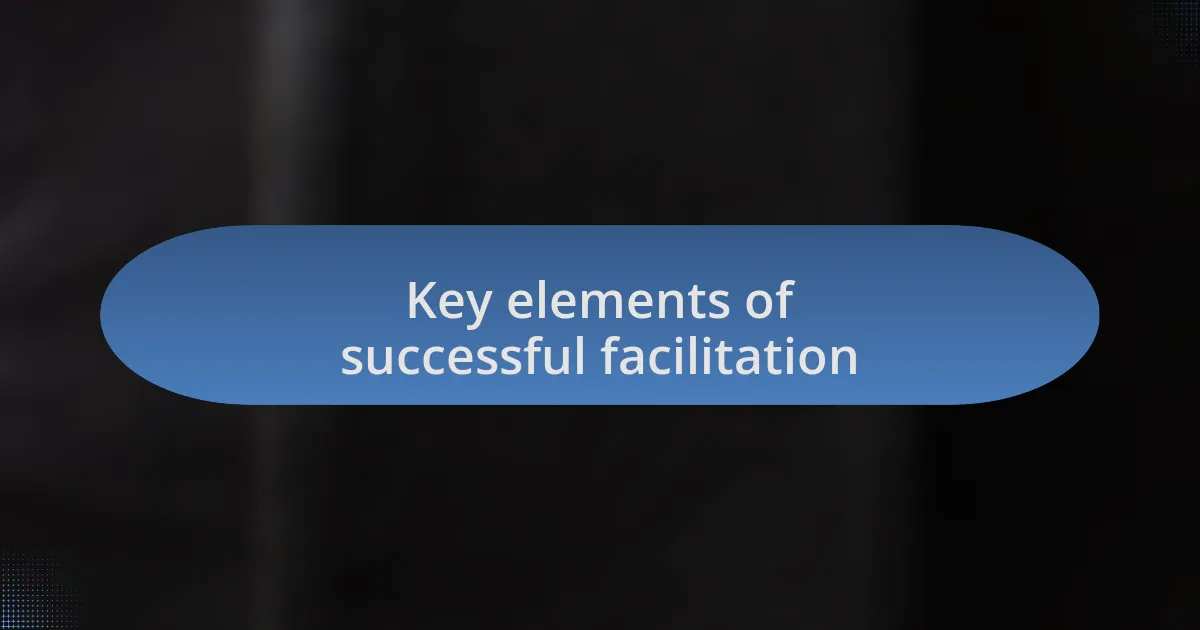
Key elements of successful facilitation
Facilitating meaningful dialogue involves several key elements that can truly transform the experience for participants. One essential aspect is establishing a safe and open environment where everyone feels comfortable expressing their thoughts. I remember a session where I encouraged participants to share their honest feedback on a controversial topic. It felt exhilarating to watch as their initial hesitance melted away, replaced by genuine curiosity and engagement. Have you ever felt that shift in a room when people realize they can truly be themselves? It’s as if the atmosphere becomes electric with possibility.
Active listening is another cornerstone of successful facilitation. When I make it a point to reflect back what someone has said, I can see their eyes light up, knowing someone genuinely cares about their opinion. This validation often leads to richer conversations and deeper insights. There’s a profound level of connection created when we listen not just to respond but to understand. It makes me wonder, how often do we practice that level of engagement in our daily interactions?
Lastly, adaptability plays a crucial role in effective facilitation. There have been times where I had to pivot my approach mid-session based on the group’s dynamics. I once led a workshop that didn’t go as planned; the discussion took an unexpected turn that felt more authentic to the participants. Embracing this spontaneity allowed for a deeper exploration of uncharted territories in our conversation. Isn’t it fascinating how following the group’s lead can open up avenues for discussions we never anticipated?
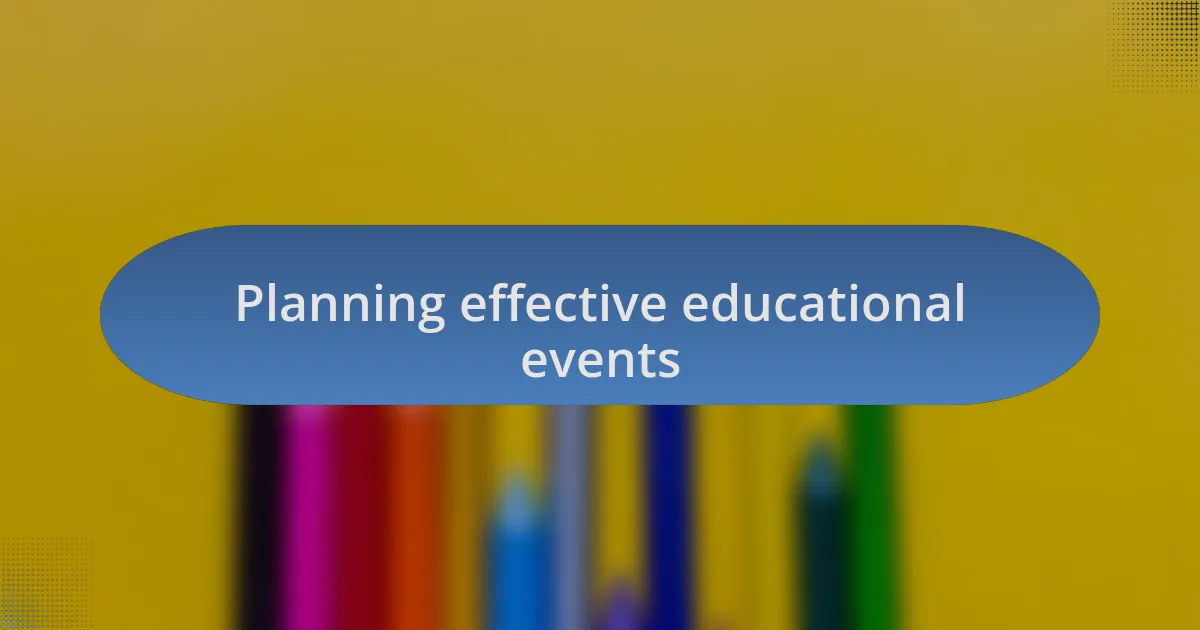
Planning effective educational events
When I plan educational events, I often start by defining clear objectives. Recently, I orchestrated a workshop focused on critical thinking skills. By identifying what I wanted participants to take away, I found it easier to develop engaging activities that aligned with those goals. Have you ever realized how much more effective an event can be when everyone knows its purpose?
Another crucial aspect I consider is the logistics of the venue. I recall an event where the seating arrangement played a significant role in fostering interaction. Instead of rows, I opted for a circular setup that encouraged collaboration. It was incredible to see participants lean into each other’s ideas, creating a vibrant atmosphere. Doesn’t it make a difference when the space itself promotes interaction?
Lastly, I try to incorporate moments for reflection within the agenda. During one session, I added short breaks for individual journaling after intense discussions. The feedback was overwhelmingly positive, as that time allowed participants to process their thoughts more deeply. Have you ever noticed how a pause can transform the energy in the room, giving everyone a chance to connect with their own insights?
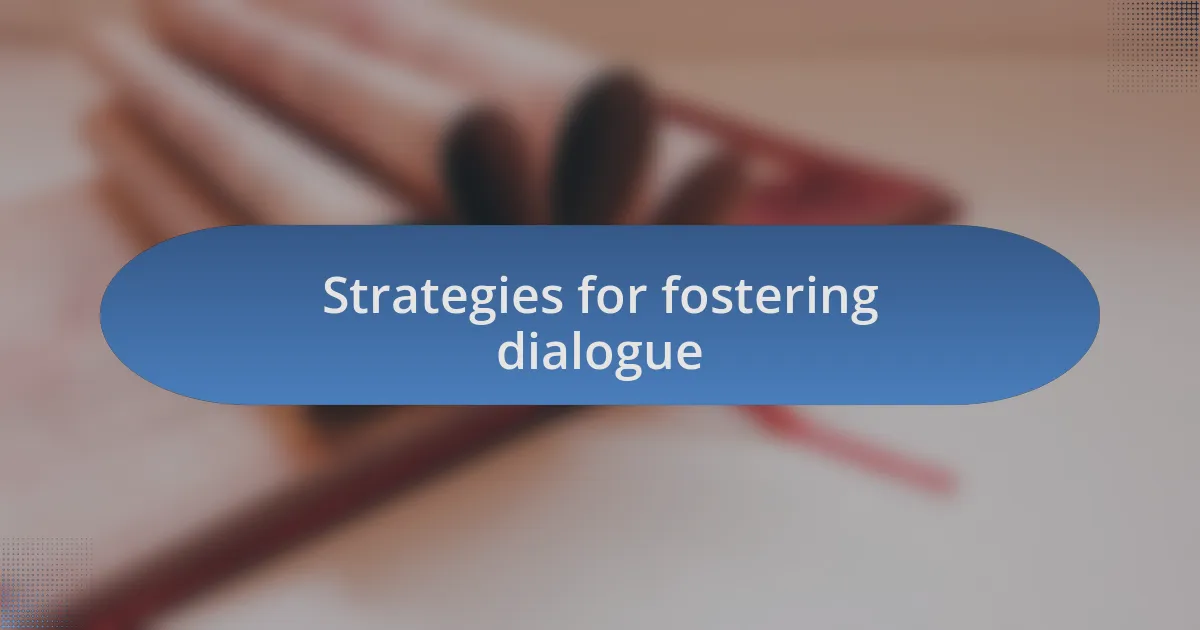
Strategies for fostering dialogue
Fostering dialogue begins with creating a safe space where participants feel comfortable sharing their thoughts. I remember a session where I opened with an icebreaker activity, asking attendees to share a personal learning experience. This simple step not only broke the tension but also built trust among participants, setting the stage for deeper discussions. Have you ever noticed how sharing personal stories can help ease a group into a collaborative mindset?
Another strategy I employ is active listening. During a recent workshop, I made a conscious effort to paraphrase participants’ contributions before responding. It was fascinating to see how this approach prompted others to build on those ideas, sparking a more nuanced conversation. Isn’t it remarkable how acknowledging someone’s input can lead to richer exchanges?
I also find that utilizing open-ended questions can significantly enhance dialogue. For instance, I’ve used prompts like, “What does this concept mean to you?” which invites multiple perspectives rather than a binary agreement or disagreement. The outcome has often been a tapestry of insights that exceed my initial expectations, reinforcing how dialogue thrives in spaces where diverse views are celebrated. How do you encourage varied opinions in your discussions?
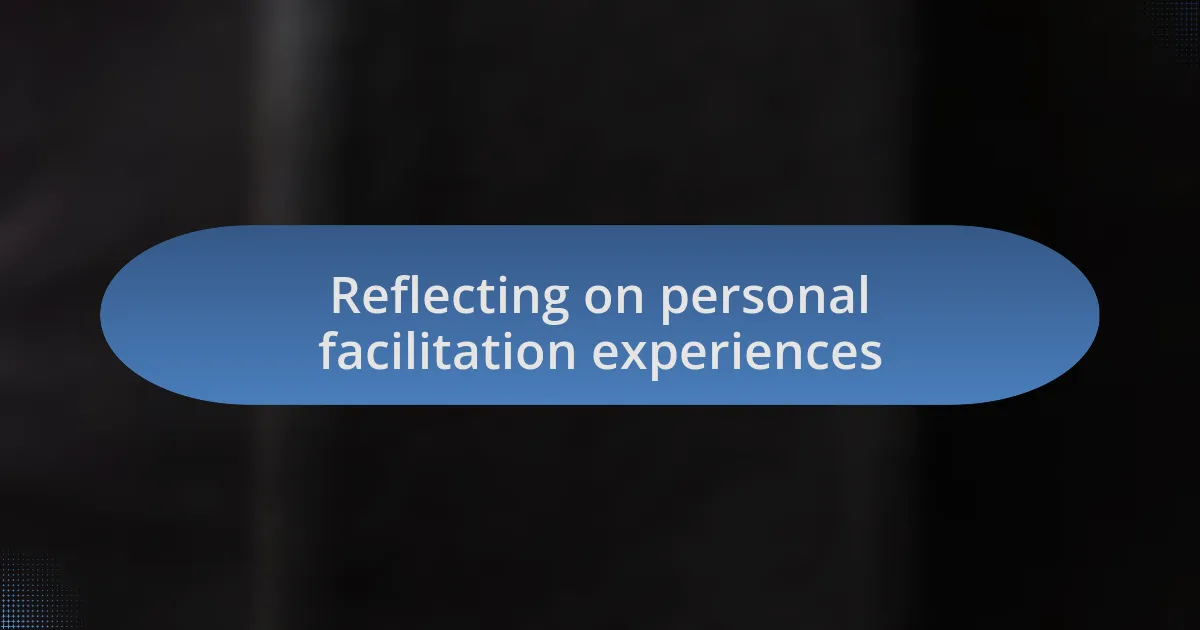
Reflecting on personal facilitation experiences
Reflecting on my experiences as a facilitator, I’ve often found that the moments of vulnerability shared by participants can be transformative. During one session focused on conflict resolution, a participant bravely revealed their struggle with a challenging workplace relationship. This honest admission encouraged others to share similar experiences, creating a space filled with empathy and understanding. Isn’t it powerful how vulnerability can open doors to healing conversations?
I also recall an instance when I underestimated the impact of non-verbal cues. While facilitating a group discussion, I noticed several participants nodding in agreement but remaining silent. This observation pushed me to pause and invite those quieter voices into the conversation. As a result, the dynamics shifted dramatically, enriching the dialogue. Have you ever thought about how much can be said without uttering a word?
In another memorable workshop, I embraced the idea of co-creating the agenda with the participants. This approach led to unexpected topics surfacing, allowing for richer conversations that aligned more closely with the participants’ needs. Stepping back to let others lead required some courage, but witnessing their excitement and ownership of the discussion was incredibly rewarding. How do you engage participants in shaping their own learning experiences?
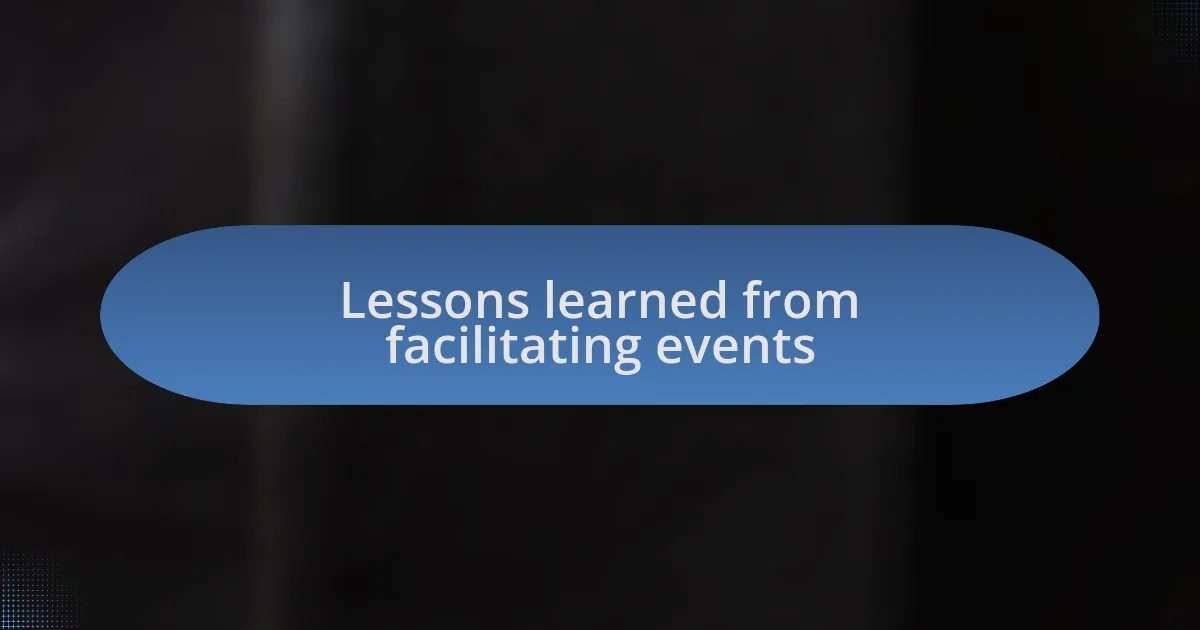
Lessons learned from facilitating events
When facilitating events, I’ve learned the importance of creating a welcoming environment where everyone feels safe to share. I recall a workshop where I introduced a simple ground rule: “No wrong answers.” The shift in energy was palpable. Participants who initially held back began sharing bold ideas. It made me wonder—how can the right atmosphere transform group dynamics?
One lesson I hold dear is the significance of active listening. During a session on collaborative problem-solving, I made a conscious effort to summarize participants’ points before responding. This practice not only validated their contributions but also encouraged deeper exploration of their thoughts. Have you ever considered how powerful it can be to make someone feel truly heard?
Another insight emerged when I experimented with different facilitation styles. In one session, I employed a more structured approach, only to find that it stifled creativity. The next time, I opted for a more fluid, adaptable style, which resulted in vibrant discussions and unexpected insights. It reinforced the idea that flexibility in facilitation can lead to richer, more meaningful outcomes. How do you find the balance between structure and spontaneity in your events?